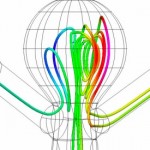Hemodynamics of diseased vessels
The details of blood flow patterns and fluid mechanical forces in vessels affected by atherosclerosis and aneurysm have implications for the diagnosis and treatment of these diseases. Clinical imaging modalities provide insufficient and sometimes misleading information about the risks of atheroslcerotic plaque rupture or aneurysm rupture. Using computational fluid dynamics (CFD) and experimental methods including particle image velocimetry (PIV), we model these flows in order to better understand them.
Blood flow in diseased vessels is complicated by blood’s non-Newtonian behavior at low shear rates; by the tortuous, curved and branching human vasculature; by the tendency of severe atherosclerosis to trigger instability and transitional flow; and by the nonlinear behavior of vascular walls and the interaction between solid and fluid mechanics. We also consider the impact of these complications on our models.
Representative publications include the following:
- Albert* Balaban Neufeld & Rossmann J. Biomechanics, 2014 Link
- Cummins* & Rossmann ASME J. Biomechanical Engg, 2010 Link
- Rossmann J. Mech Behavior Bio Materials, 2010 Link
- Fisher* & Rossmann ASME J. Biomechanical Engg, 2009 Link
- Utter* & Rossmann J. Biomechanics, 2007 Link
- Stroud, Saloner & Berger J. Biomechanical Engg, 2002 Link
Aerodynamics of sports balls
What makes a curveball curve, a cricket ball googly, or a Wiffle ball z ig when you thought it would zag? Experiments on sports balls illuminate phenomena such as the transition to turbulence, the Magnus effect, and trapped vortices. In 2017, I wrote about the sociology, design, and aerodynamics of baseball and Wiffle ball for The Atlantic. In 2020, I spoke about the aerodynamics of Wiffle ball on NPR’s ShortWave podcast.
ig when you thought it would zag? Experiments on sports balls illuminate phenomena such as the transition to turbulence, the Magnus effect, and trapped vortices. In 2017, I wrote about the sociology, design, and aerodynamics of baseball and Wiffle ball for The Atlantic. In 2020, I spoke about the aerodynamics of Wiffle ball on NPR’s ShortWave podcast.
Representative publications include
My Wiffle ball work is also featured in the March 2011 issue of Wired magazine, and in April 2014 in Popular Science.
SOTL, pedagogical, and higher ed scholarship
I’m committed to progressive, inclusive engineering education, and to engineering as a facet of prismatic liberal education. Some representative publications in the scholarship of teaching & learning and other higher ed topics:
- Rossmann & Armstrong, Empowering and Liberating: WGS coursework and STEM students 2022
- Rossmann & Armstrong, WGS fosters engineering identity formation 2021 – Awarded Best Paper at 2021 ASEE conference
- Koh & Rossmann, Strategic disruptions toward more liberatory engineering education, 2021
- Rossmann & Cohen, The internet is railroads, 2021
- Rossmann & Sanford 2019, and Rossmann, Sanford, Cohen & Nicodemus, 2020
- Rossmann & Stewart-Gambino, Multidisciplinary Cornerstone Design for “Grand Challenges” 2019 Link
- Rossmann & Stewart-Gambino, NAS Commissioned Research on Interdisciplinary Education, 2015 Link
- Cohen, Rossmann, & Sanford Bernhardt, Engineering as a sociotechnical system, 2014 Link
The Second Edition of my textbook integrating solid and fluid mechanics with significant historical context, co-written with Clive Dym and Lori Bassman, was published in 2015. I joined Team Mase as co-author of the Fourth Edition of Continuum Mechanics for Engineers, published in 2020.

